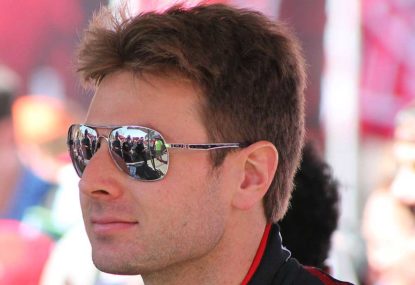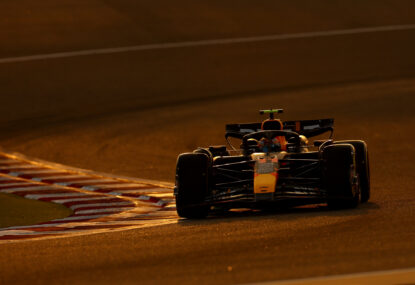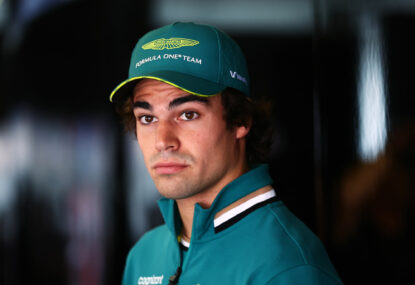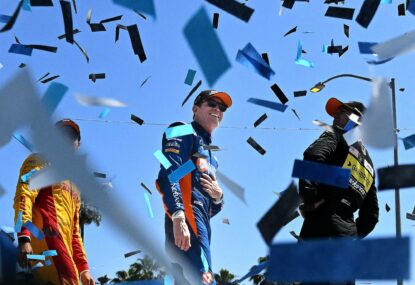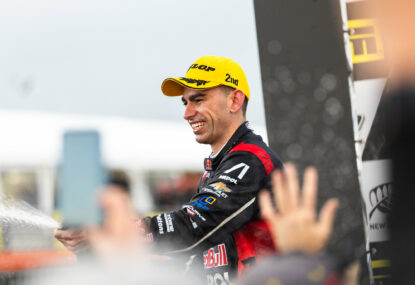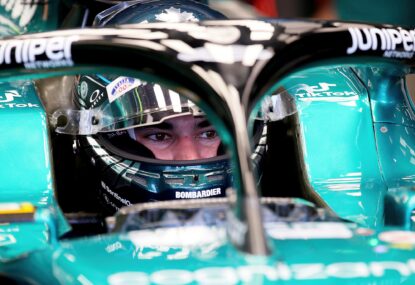Anyone who watched the MAVTV 500 at Auto Club Speedway (won by American Graham Rahal) this weekend saw one of the most jaw-dropping races of any kind that we’ve seen in years.
Long-time IndyCar Series observers are already calling the race one of the wildest in the storied history of the open-wheel category, featuring a series-record 80 lead changes at the start-finish line, and countless dozens more elsewhere around the track.
But as exciting as it was, for a while, to watch cars three, four and sometimes an astounding five wide, the situation on the track, from lap one to lap 250, was one of intense danger.
This isn’t tin-top racing. Open-wheel cars shouldn’t look like fighter jets diving in and out of packs, running at least four-wide, two and three rows deep, bumping wheels, and trading paint at more than 200 miles per hour.
Except that that’s exactly what happened all day long at the wide and fast Auto Club Speedway, where, a few years ago, the worldwide closed course record of more than 241mph was set. That should be an indication of the speeds that this track can produce.
I watched the race with a foreboding sense of doom, almost holding my breath, not so because the racing was so exciting, but because I had a feeling it was going to end horribly. In a way, yes, it was entertaining, with so much slicing and dicing, but, more than that, it was scary.
I was scared for those drivers. More by luck than good management there were no serious injuries. All the drivers are going home to their families tonight, and for that we should feel incredibly lucky.
Particularly Australians Will Power and Ryan Briscoe, American Ryan Hunter-Reay and Japan’s Takuma Sato. Power and Sato tangled with less than 10 laps to go after Sato bumped wheels with Scott Dixon in the middle of an angry pack, slid up the track and slammed Power and himself into the wall.
Then, with two laps left, Hunter-Reay and Briscoe came together, the incident punting Briscoe into the grass where his car leapt into the air, flipped over and over, and came to a shuddering halt. For a moment, everyone held their collective breath, but Briscoe flipped a double thumbs-up to signal that he was OK. Thankfully, there were no lasting injuries.
It’s not like the series doesn’t know what the worst-case scenario is when it comes to pack racing – in the final race of the 2011 season, at the Las Vegas Motor Speedway, with a similar aero package on the cars, a horrific accident claimed the life of two-time Indianapolis 500 champion Dan Wheldon, shocking the tightknit IndyCar paddock to it’s very core.
Whether you’re a driver, crew member, official or fan, no one who witnessed the fence-tearing crash that took Wheldon’s life will forget it. In many ways, the series is still recovering from the loss of the incredibly popular Brit. His close friends in the paddock, guys like Tony Kanaan, Dario Franchitti and Bryan Herta, haven’t been the same since.
In the aftermath of today’s race, influential faces in the paddock spoke out about the aero package that promotes this sort of white-knuckle racing. Team Penske president Tim Cindric indicated that he and his drivers had known from the beginning of the weekend that the aero package IndyCar mandated for this race was going to produce exactly what we saw on Saturday afternoon. Their pleas for change fell on deaf ears.
Cindric revealed he had sat down with IndyCar officials after Wheldon’s death in an effort to make the circumstances surrounding the accident – a fast banked, and a particular sort of aero package – was never repeated. Nearly four years down the road, it has been repeated.
Mark Miles, the CEO of the IndyCar series has allowed this to happen on his watch, when he could have mandated changes, and he should be called to account for it.
It’s not like the series didn’t have ample warning that this was coming. NBC showed a package in practice of what cars were doing. It was always going to be emulated under race conditions.
Australia’s Will Power was less subtle than his boss, and appeared visibly shaken when interviewed post-race on NBC.
“What are we doing? What are we doing? We went in there and told [IndyCar] it would be pack racing, and that was a [Las] Vegas situation right there,” he said.
2014 Indianapolis 500 champion Tony Kanaan said, it was “a great race for the fans”.
“I get criticised a lot when I talk about these things. But people are not in the race car at 215 mph doing this to see… I would like you guys to try – the people that criticise us,” he sad.
“It’s tough, it’s stressful; it makes you think if you still want to keep doing this like that. Hopefully we get together and come up with a better solution.”
CFH Racing co-owner Ed Carpenter disagreed on Twitter, suggesting that any driver who didn’t want to race in these conditions should retire. Let it be said that Carpenter is the stepson of former Indy Racing League boss Tony George, whose high downforce cars pioneered this sort of racing in the early years of this new millennium.
It was an unwise thing to say, considering everything that has happened. The racing was seriously and frighteningly dangerous. It’s lucky that no one was seriously hurt. Some of the television pictures were spectacular for a while, until you realised that the entire field was on a knife-edge all afternoon. Five hundred miles worth of knife-edge!
I love good racing, but this was a kind of Russian roulette, and asking drivers to take those extreme risks week-in, week-out is unfair. It’s a testament to the skill of the IndyCar Series drivers that there weren’t more serious consequences.
The MAVTV 500 should be the last race of it’s kind. That wasn’t racing, it was unhinged insanity. IndyCar officials are playing with people’s lives here. It has to stop.





























































































